Strategies to go beyond the Minkwitz theorem
The different types of progressive addition lenses that are nowadays in the market have been created using a wide range of mathematical tools. With the actual state of the art, many different types of progressive designs are being designed, which show a wide variety of distribution and levels of lateral aberrations. It is commonly accepted that the Minkwitz theorem [1] affects the distribution of lateral aberrations, but we will explain this is only true up to a certain extent. A detailed analysis of the Minkwitz theorem and two generalizations of it [2] and [3] that appeared last year have contributed to change this perception and more can be understood now. However, as we will see in this article, some design strategies are not so obvious and can even go beyond.
Progressive lenses and the Minkwitz theorem
A progressive addition lens (also called progressive lens) is a lens that corrects the lack of accommodation caused by presbyopia allowing the eyes to focus clearly at different distances. They are commonly described in four different regions: a distance zone in the upper part, a near zone in the bottom part, a corridor that joins it and the sides of it. This corridor is used for intermediate distances and has a gradual change in power from the far zone to the near zone, whereas the forth zone is on the sides and it always includes some level of aberrations in the form of astigmatism. Usually the near zone is laterally shifted a certain number of millimetres (between 0mm to 4 or 5mm) to suit the eyes convergence of the user when looking at a closer distance. In Figure 1 (left) the different parts of a progressive lens are shown. Since the appearance of progressive lenses back in the 1960’s, progressive designs have improved a lot. Lateral astigmatism has decreased over the years, while smoothness has improved. It is commonly said that the Minkwitz theorem [1] produces lateral aberrations, but we will see that this is only true up to a certain point.
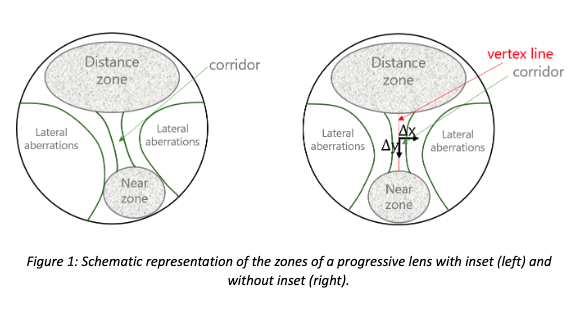
The Minkwitz theorem [1] was published at 1963 and refers to the umbilical points of the vertex line of a symmetrical refracting surface. In terms of a progressive lens, the theorem refers to progressive lenses with no inset (i.e. symmetrical) and without astigmatism in the vertex line (umbilical). The vertex line is the very thin line in the centre of the corridor (see the red line in Figure 1). That means that the theorem only refers to progressive lenses having a line of points with astigmatism 0D along the centre of the corridor. The Minkwitz theorem states that in the above mentioned conditions (i.e. the points of astigmatism 0D situated in the centre of the corridor), lateral astigmatism very near to the centre line, and in a direction perpendicular to that centre line, increase twice as much as the increase of power in the vertical direction of the corridor line. Mathematically, Minkwitz theorem can be expressed as follows:
∂Ast(x,y)∂x=±2∙∂Pow(x,y)∂y (1)
The expression ∂Ast(x,y)∂x is the derivative of the astigmatism with respect to x that represents the horizontal growth of the astigmatism. Similarly, ∂Pow(x,y)∂y is the derivative of the power (Pow) with respect to y (vertically), which represents the vertical increase of power in the corridor line. We also remark that the expression . refers to the limit when x is very near to the zero, i.e., for the points very near to the vertex line, that is the center of the corridor. The expression very near in mathematics is understood as an infinitesimal distance from the vertex line, and it would be, for sure, less than 1mm from the vertex line. In this sense, Formula (1) can be approximated as follows:
∆Astx,y∆x=±2∙∆Pow(x,y)∆y (2)
where (x,y) refers to any point in the vertex line with astigmatism 0D and the expression ∆ refers to the increase (of power or astigmatism).
Therefore, the Minkwitz theorem states that for points in an infinitesimal distance from the vertex line, situated in a direction perpendicular to the vertex line, the astigmatism grows twice as much as the change of the power. If Minkwitz theorem was strictly true for the whole surface of a progressive lens, the lateral astigmatism would reach around 4D for a plano progressive lens with power addition of 2D. Fortunately for all the progressive lens users, this is not strictly true, and in most of the cases a plano power addition of 2D reaches around 2D of lateral aberrations, which makes them much comfortable to wear.
There are at least two reasons why progressive lenses are better than this theorem predicts. First reason is that Minkwitz theorem can only be applied to a surface where the vertex line has astigmatism 0.0D and most of the progressive lenses that are in the market, if not all, allow some level of astigmatism in the vertex line. This level of astigmatism can go from 0.03D up to 0.12D or even more and, in this situation where astigmatism is more than 0D, Minkwitz theorem does not apply.
The second reason and more important, is that Minkwitz theorem is only true in an infinitesimal distance from the corridor. As we mentioned above, mathematically an infinitesimal distance means a very small distance, which is for instance less than 1mm. This means that the Minkwitz theorem does not predict how much the level of lateral astigmatism would be in distance beyond 1mm from the corridor. It is important to point out that in the original abstract of Minkwitz publication [1] nothing was mentioned about this restriction that this theorem only applies in an infinitesimal distance from the corridor. It is necessary to read the whole article and carefully study the formulas to understand that this is only true near the corridor.
It is also interesting to see how many other articles, such as [4] (p. 111), but also many others, quote the Minkwitz theorem without mentioning that it is only true near the corridor. From our point of view, these incomplete references of Minkwitz theorem have created a general misunderstanding of the Minkwitz theorem in many people in the ophthalmic field.
There is also a third reason why Minkwitz theorem does not apply to most of the progressive lenses that are commercialized nowadays, and this refers to the fact that Minkwitz theorem only can be applied to lenses with no inset, which means that lenses where the near zone is shifted horizontally are excluded.
Extension of the Minkwitz theorem
However, two articles [2] and [3] appeared last year and generalized the Minkwitz theorem for nonumbilical lines. The first article [2] extends the Minkwitz theorem to surfaces with astigmatism in the vertex line, while the second [3] also generalizes the Minkwitz theorem for non-symmetrical surfaces and a more generalized distribution of astigmatism.
At first sight it seemed like good news, but the main drawback of both articles is that again, these new theorems can only be applied to areas very close to the vertex line. This means that for areas farther from the corridor these generalizations of the theorem do not give us much information about how the distribution of the astigmatism will be in the rest of the surface.
In fact, in the discussion of [3] it was clearly said that this generalization of Minkwitz theorem can be applied “at least in the direct surroundings of the principal line”. In addition, this article refers to the “infinitesimal neighbourhood of a point P”, which means very near the vertex line.
Definition of the progression line and the corridor length
Before we display some examples of progressive lenses and analyse how they bypass the Minkwitz theorem, we need to agree about some definitions.
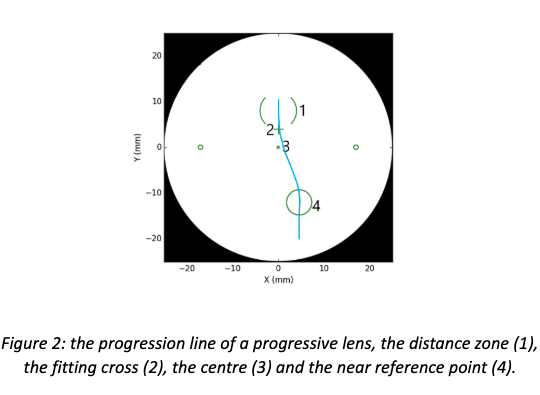
The fitting cross is the point designed to be placed in front of the user pupil. Once the fitting point is centred, other areas of the lenses can be defined. The distance reference point is very often located 4mm above the fitting cross and it is the centre of the zone that is used to see in far region. Distance region is represented with a big parenthesis (1) in Figure 2.
The near reference point is located a variable number of millimetres below the fitting cross. The exact number of millimetres is what defines the corridor length. In addition, the near reference point is commonly shifted horizontally from the fitting cross towards nasal. This shift is known as the inset.
There are, however, some discussions in the literature about what the definition of the corridor length of a progressive lens should be. Some people claim the corridor length originates in the fitting cross. Others, from the centre of the progression. Some designers define the corridor length up to the near reference point, while others up to the fitting height. In this article we will consider the corridor length as the vertical segment from the fitting cross to the near reference point where the addition is measured. In addition, all the examples shown below will be plano addition 2.0 without position of wear, which means that cylinder and sphere in the distance reference point will be 0D and the addition measured in the near reference point will be exactly 2.0D.
The progression line is the blue line showed in Figure 3 and it is usually known as the umbilical line of the progressive design. It goes through the point (x=0, y=10), the fitting cross, the near reference point and then down to the point (x=inset, y=-20). In the examples displayed below we will show the astigmatism and the power along the progression line. The progression line is a smooth curve and not a polygonal line in order to better suit the natural movement of the eyes, from the far vision to the near region.
Apart from the varying profile of the power along the progression line, we will consider the value of the power at the distance reference point to be zero and the value of the addition in the near reference point will be exactly 2D for all the examples shown in this article. Beyond this point, however, the power value does not necessarily stabilize. All these characteristics are part of the philosophy of a progressive lens design and will help us distinguish one design from another.
Strategies to skip the Minkwitz theorem
Example 1: Nominal corridor versus real corridor
Let’s start with an introductory example using two very different progressive lenses that have equal corridor length but different addition profile, shown in Figure 3. These are two plano power addition 2D examples with a corridor length of 15mm , i.e. the near reference point is 11mm below the fitting cross (that is 4mm above the centre of the lens).
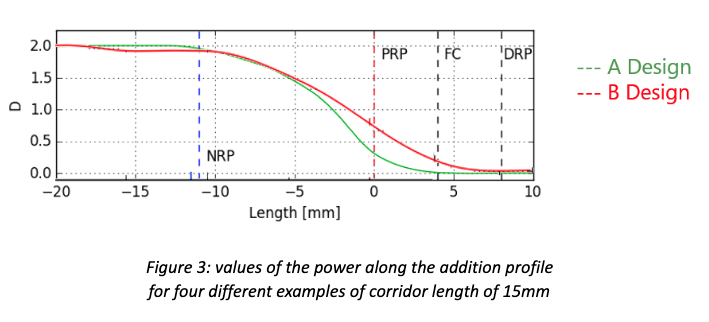
Although the nominal corridor length is equivalent, different addition profiles will cause a different local variation of the power and, according to Minkwitz theorem, one can expect different astigmatism maps (shown in Figure 4). The steeper the addition profile at a given point the more aberrations will appear on either sides of the corridor and the narrower it will become. Obviously, it is also expectable that the rest of the map will be influenced to some extend by these differences in the progression profile and as a result, the whole map can be expected to have noticeable differences.
In other words, Minkwitz seems to directly influence the outcome of these two designs.
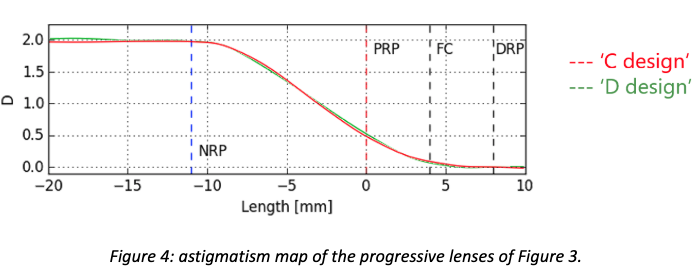
But does this introductory example mean that different addition profile along the progression line is what is directly causing different distributions of astigmatism? In the following examples we will see that the answer is not always.
Example 2: Addition profiles match but astigmatism maps clash
Let’s consider now two different progressive lenses with the extremely alike addition profiles (Figure 5). Both examples have a corridor length of 15 mm. According to the purest Minkwitz and according to what we have seen in the previous example astigmatism distribution should be very similar or, according articles [2] and [3], not differ excessively.
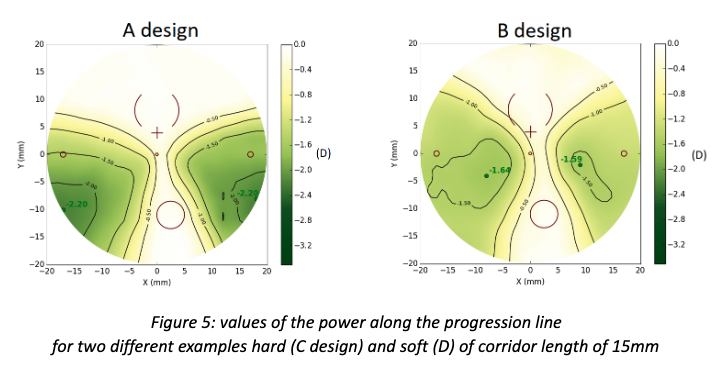
However, this turns out to be the opposite, as you can see in Figure 6. To begin with, one progressive design has the maximums of astigmatism very far to the corridor while the other has both maximums of astigmatism near the corridor. In addition, although the corridor width is apparently similar in both designs, aberrations grow much faster in the C design as you move to the sides.

Aberrations have been spread to areas with less use in the case of design D and as a gain, the total amount of astigmatism on the sides is greatly decreased. As the reader may have guessed, this is the typical case of a hard design versus a soft design. Hard designs are usually described as having wider near and distance areas and having larger amount of astigmatism on the sides. Soft designs are usually described as having narrower far and near areas while keeping the total amount of lateral astigmatism much lower.
This strategy was very successful ten years ago when softer types of designs were introduced, as can be found in reviews [6] and [7].
Therefore, this example clearly reveals that for a given addition profile nothing can really be predicted about the resulting astigmatism map and Minkwitz turns out to be of little help here. Instead, cleverly playing with aberration distribution allows to decrease the cylinder amount in some useful areas while worsening less critical ones.
But does this second example mean that the same addition profile along the progression line with the same level of hard/soft features will produce the same distribution of astigmatism? In the following and last set of examples we will see that the answer may not be so straight forward.
Example 3: Beyond any theorem
Let’s analyse now another example having almost identical corridor profile and exactly the same widths of distance zone, intermediate zone and near zone, i.e., the same level of hard/soft features, as we defined them before. And surprisingly, these lenses show different levels of astigmatism.
Addition profiles and the astigmatism distributions are show in Figures 7 and 8.
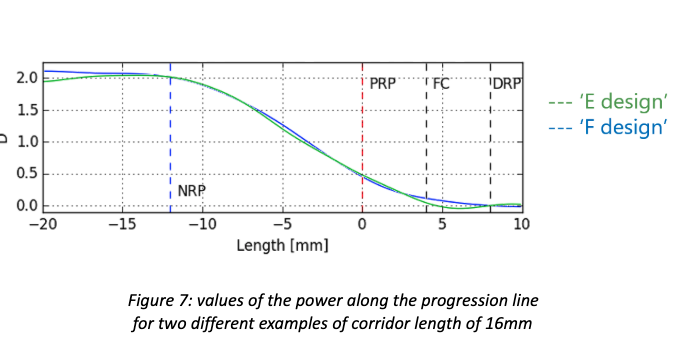
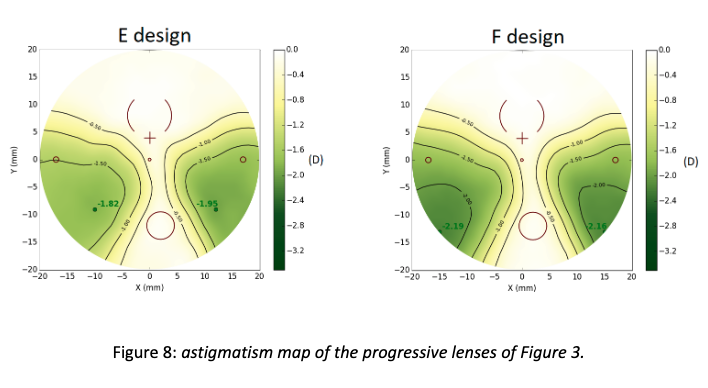
This case is not described in the literature and it does not seem to be explained nor by the Minkwitz theorem, nor by their extensions and not even by the intuitive idea that one can freely play with the distribution of aberrations. The ultimate explanation behind these examples lay deep in R&D departments of design companies. Some patents, such as the one related to Clearview technology [5], give some hints of what lays behind them and it becomes quite obvious that the latest generation of mathematical optimization methods that are currently used are the ones to blame for. However, it is worth pointing out that only a 40mm diameter map is shown here and we do not see at all what is going on outside this circle. An educated guess would lead us to suspect that a combination of all the tricks we talked about before plus some features located outside the shown areas can probably explain the observed differences among these two maps.
And this is not an isolated case. Another similar example with an almost equal addition profile and similar distance, intermediate and near zone widths is shown in Figures 9 and 10. And just like before, astigmatism distribution is surprisingly different: H design shows lower values in both maximums of astigmatism than G and even the 2.0D temporal isolines of G has completely disappeared in H, making the latter much smoother. Once more, nor Minkwitz, nor revised Minkwitz, nor conventional hard/soft technology can account for this improvment and the explanation to this effect has to be looked for again in the optimization method of the whole surface.
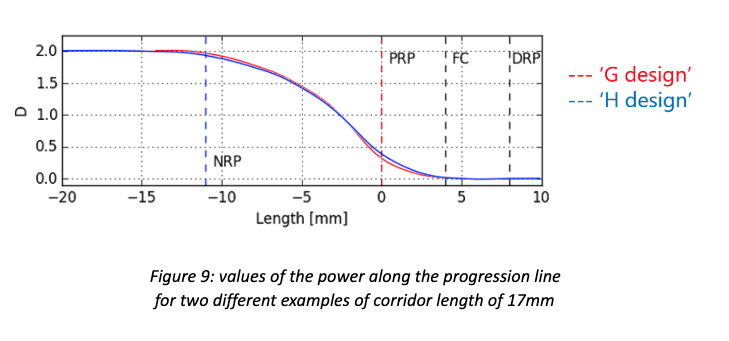
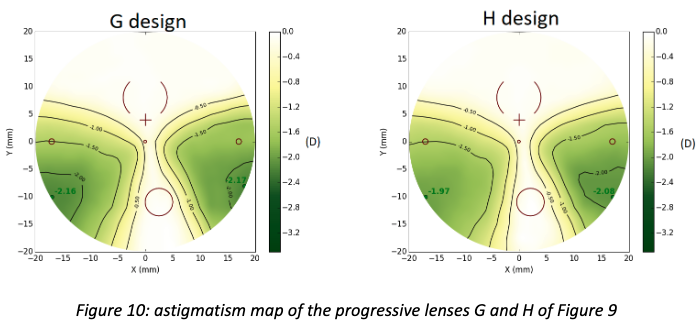
As a conclusion, we can say that Minkwitz theorem itself does not explain very well most of the progressive lenses one can find in the market nowadays. Minkwitz did an excellent job back in 1963 to mathematically demonstrate it was not possible to get rid of the aberrations near either side of the corridor of a progressive lens, and this was a very remarkable milestone when many people were wondering if aberration-free progressive lenses could ever exist. Fortunately, progressive lenses are much better today than fifty years ago since high-quality products that can be found in the market today are the result of improving the mathematical methods to optimize progressive surfaces combined with a better understanding of the limits of perception of the human sight. This allows designers to place the unavoidable aberrations that Minkwitz taught us, where they annoy less and in the form they are less noticeable by ophthalmic lens wearers. Progressive lenses have evolved considerably since then and we are convinced they will continue to do so in the future.
Bibliography
[1] G. Minkwitz, G. Minkwitz, “Über den Flächenastigmatismus Bei Gewissen Symmetrischen Asphären”, Optica Acta: International Journal of Optics, 10:3, 223-227 (1963). [“On the surface astigmatism of a fixed symmetrical aspheric surface”]
[2] G. Esser, W. Becken, H. Altheimer, and W. Müller, “Generalization of the Minkwitz theorem to non-umbilical lines,” Journal of the Optical Society of America A, Vol. 34, No. 3, pp. 441–448 (2017).
[3] R. Blendowske, “Simple approach to the generalized Minkwitz theorem”, Journal of the Optical Society of America A, Vol 34, No. 9, pp. 1481-1483 (2017).
[4] Günther H. Guilino, “Design philosophy for progressive addition lenses”, Applied Optics Vol. 32, Issue 1, pp. 111-117 (1993).
[5] J.C. Dürsteler, J. Vegas Caballero, M. Espínola Estepa, S. Chamadoira-Hermida, G. Casanellas Peñalver, “Procedure for designing a progressive ophthalmic lens and corresponding lens”, US8770748B2.
[6] Meister, D. J., and Fisher, S. W., Progress in the spectacle correction of presbyopia. Part 1: Design and development of progressive lenses. Invited review, Clinical and Experimental Optometry 91:3, 240–250 (2008).
[7] Meister, D. J., and Fisher, S. W., Progress in the spectacle correction of presbyopia. Part 2: Modern progressive lens technologies, Invited review, Clinical and Experimental Optometry 91:3, 251–264 (2008).
Do the progressive
Article publish in MAFO magazine edition 1-19.
Infrared radiation
Article publish in MAFO magazine edition 4-18.


